The lights from the wharf cast an iridescent glow upon the river, creating cascades of blue, green, orange and purple. Couples stroll by Lover’s Bridge (情人橋), marveling over its quaintness. Tourists with clunky cameras line up in front of street vendors to place their orders for fried squid on skewers. Further down Tamsui Old Street (淡水老街), ritzy restaurants and coffee shops line the wharf where fishermen’s dwellings once stood.
Centuries ago, this neighborhood in present-day New Taipei City bore the brunt of encroachment from various European powers. Remnants of what Tamsui District (淡水區) used to be can still be found in traces — notably in the busted walls and cracked bricks, refashioned to make way for nautical-themed watering holes serving Hoegaarden and other beers. Tourism has long replaced fishing as the main commercial activity in Tamsui, and now that summer is back, the riverside suburb can expect to see a surge of visitors seeking reprieve from the unbearable heat.
One way to enjoy the evening breeze while taking in the sights, hassle-free, is through a dinner cruise. Since its launch in 2007, the Great River Queen (大河之戀皇后號), a 40.5-meter long replica of a Mississippi paddle boat, has been offering luxury tours and hosting blues bashes along the Tamsui River (淡水河). This summer, the liner will be offering dinner cruises every Friday and Saturday night.
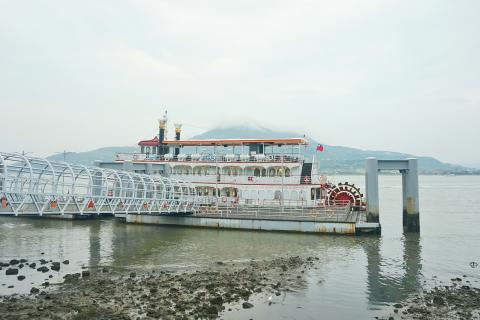
Photo: Dana Ter, Taipei Times
Trying to find information in both Chinese and English about the dinner cruise is like attempting to break the Da Vinci code. Ignore their archaic Web site, which is all in Chinese and tells you to fax them your reservation (who uses fax anymore?). Simply call and reserve your spot a few days in advance and pick up your tickets the day of the cruise at least 15 minutes prior to departure. Boarding starts at 6pm, the boat leaves the wharf at 6:30pm and returns at 8:30pm. The Great River Queen is docked at Sanqi Passenger Boat Wharf (三期客船碼頭) along the Old Street and is hard to miss — just look out for the three-story high white liner with lit lamps and off-white curtains that are visible through shiny windows.
For the quality of the food and the views, the cruise is reasonably priced at NT$1,500 per person. The interior is ornate with blue-and-white striped chairs and glittering chandeliers. Out on the deck, the sound of the water lapping gently and the stillness of the surrounding mountain range has a calm, lulling effect.
ALL YOU CAN EAT
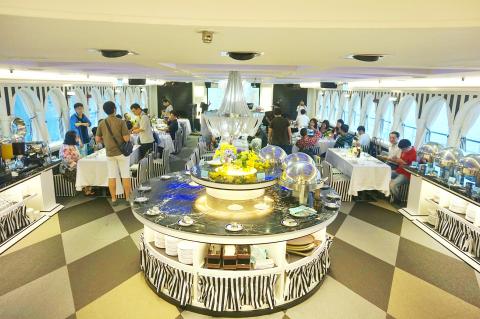
Photo: Dana Ter, Taipei Times
The buffet starts at 6:30pm and includes a decent selection of Taiwanese and Western-style food (seafood was sorely lacking on the menu, though). The smoked chicken breast was one of my favorites. Light, thinly sliced and tender, the meat has a savory flavor that dissipates slowly in your mouth, although it could have been crispier on the outside. It also could have benefited from a sprinkling of pepper.
The beef bourguignon is a close contender. Although it bears only a slight resemblance to the original French dish and the stew is a little too soggy, the small chunks of beef served with carrots and celery are nicely simmered to produce a tender, stringy texture that dissolves in your mouth. I’m not a fan of huge, chunky slabs of meat, so I liked the watery stew which softened the beef. Another delightful dish is the char siu (Cantonese-style barbecued pork). Lightly roasted on the outside, the meat has a mild, honeyed taste. Likewise, the chicken wings are nicely fried and tender, crispy on the outside and soft on the inside.
If fish is more of your forte, try the Taiwanese-style steamed fish with tofu and scallions. Light, silken and opaque, it provides a nice contrast to the heavier, richer dishes. Pairing well with the fish is the bok choy (Chinese cabbage) and minced pork and chives dumplings. The bok choy tastes leafy and nutritious, while the dumpling skin is moist and savory.
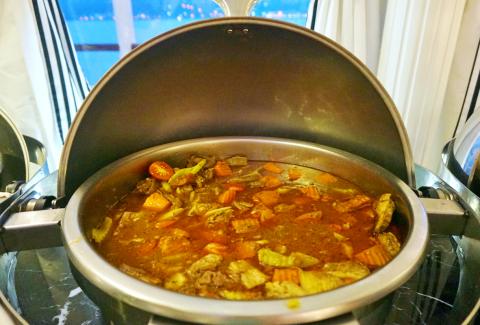
Photo: Dana Ter, Taipei Times
The fried rice is nothing out of the ordinary and I would give the sushi — which is too sticky — a miss. The desserts are half-and-half — some are delightful while others miss the mark. Don’t let the name “sticky rice ball” put you off — it is a must-try for those wanting to sample Taiwanese sweets. With various flavors such as sesame and coconut, this concoction is essentially sugary goodness wrapped in a thin, gooey outer layer. Moving on to mini pancakes — dainty and fluffy with taro — which are something worthy to be served on a high tea platter. The chocolate cake was rich and velvety but could have been runnier. Finally, the panna cotta was simply too gelatinous.
Half an hour into your meal, weather permitting, it might be a good idea to bring your desserts up to the third floor deck. There are tables, chairs and a few sofas there, making for a relaxing, breezy vibe. Most importantly, your ears will need a break from the “live entertainment” next to the buffet table — a female singer, whose voice sounds like a cross between a screeching banshee and drunkard on karaoke night, crooned sappy loves songs for the entire two hours.
Regardless of whether or not you enjoy the live “music,” it’s more pleasant on the upper deck with unobstructed views of untamed mountains in the distance that make you wonder what Tamsui must have once looked like.
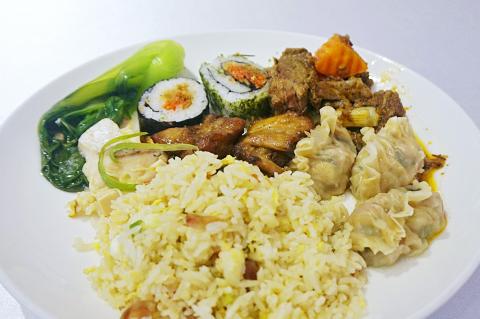
Photo: Dana Ter, Taipei Times
TO THE WATERING HOLES
Forget about drinking on board. Alcohol costs an extra NT$400 or NT$500, and the cruise returns at 8:30pm — just in time for post-dinner boozing in one of the many gastropubs along the wharf before catching the last MRT back to the city prior to midnight.
Walking along the wharf past a narrow jetty in the direction towards Fort San Domingo (紅毛城) — which was built by the Spanish in 1629 and used by the Dutch, Chinese and then the British — you’ll come across a row of narrow, two-story open-air pubs offering IPAs and regular beers. The atmosphere at these establishments is simultaneously suave and chill, allowing you to take in the sight of fishing boats without having to experience the grittiness of seafaring life.
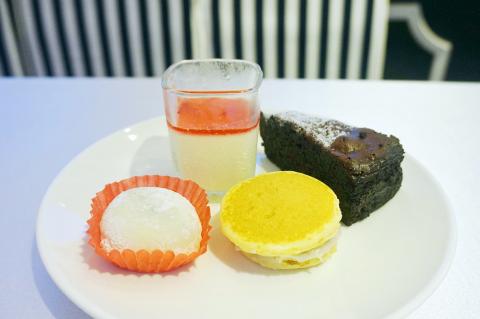
Photo: Dana Ter, Taipei Times
Another option is to try one of the coffee shops that double as barbershops by the main road leading up to the fort. The combination eludes me — are there coffee lovers who also really want to get their hair cut? Nevertheless, it’s a fun change from the usual fried food and sweet beverages from street vendors which Tamsui Old Street, like many other historic old streets in Taiwan, has come to be associated with.
Like most dinner cruises, the Great River Queen experience wouldn’t have been as enjoyable if it weren’t for the view. The buffet, while good, wasn’t exactly an epicurean’s dream. Yet, there’s something liberating about being out on the waters — a feeling which simply cannot be recreated in a regular restaurant setting. Also, Tamsui more than made up for the food by virtue of its fascinating history, quirky establishments and seafaring charm.
Warning: Excessive consumption of alcohol can damage your health.
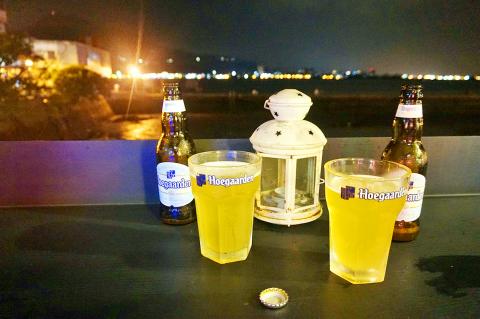
Photo: Dana Ter, Taipei Times

Anyone who has been to Alishan (阿里山) is familiar with the railroad there: one line comes up from Chiayi City past the sacred tree site, while another line goes up to the sunrise viewing platform at Zhushan (祝山). Of course, as a center of logging operations for over 60 years, Alishan did have more rail lines in the past. Are any of these still around? Are they easily accessible? Are they worth visiting? The answer to all three of these questions is emphatically: Yes! One of these lines ran from Alishan all the way up to the base of Jade Mountain. Its

The only geopolitical certainty is that massive change is coming. Three macro trends are only just starting to accelerate, forming a very disruptive background to an already unsettled future. One is that technological transformations exponentially more consequential and rapid than anything prior are in their infancy, and will play out like several simultaneous industrial revolutions. ROBOT REVOLUTION It is still early days, but impacts are starting to be felt. Just yesterday, this line appeared in an article: “To meet demands at Foxconn, factory planners are building physical AI-powered robotic factories with Omniverse and NVIDIA AI.” In other words, they used AI

Last month historian Stephen Wertheim of the Carnegie Endowment for International Peace published an opinion piece in the New York Times with suggestions for an “America First” foreign policy for Democratic presidential candidate Kamala Harris. Of course China and Taiwan received a mention. “Under presidents Trump and Biden,” Wertheim contends, “the world’s top two powers have descended into open rivalry, with tensions over Taiwan coming to the fore.” After complaining that Washington is militarizing the Taiwan issue, he argues that “In truth, Beijing has long proved willing to tolerate the island’s self-rule so long as Taiwan does not declare independence

Nov. 25 to Dec. 1 The Dutch had a choice: join the indigenous Siraya of Sinkan Village (in today’s Tainan) on a headhunting mission or risk losing them as believers. Missionaries George Candidus and Robert Junius relayed their request to the Dutch governor, emphasizing that if they aided the Sinkan, the news would spread and more local inhabitants would be willing to embrace Christianity. Led by Nicolaes Couckebacker, chief factor of the trading post in Formosa, the party set out in December 1630 south toward the Makatao village of Tampsui (by today’s Gaoping River in Pingtung County), whose warriors had taken the